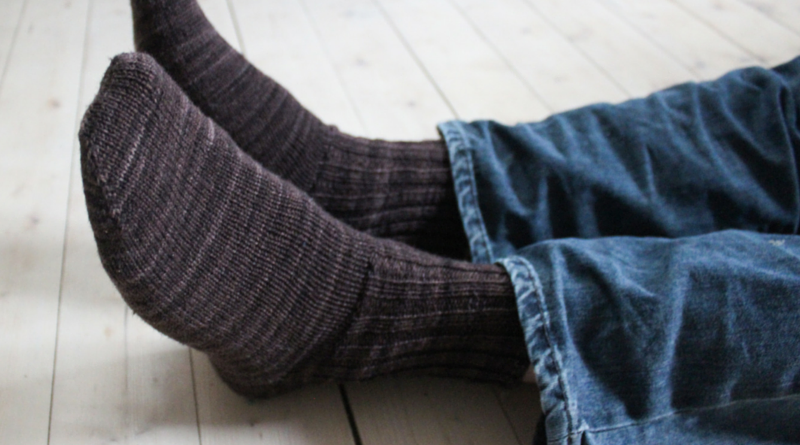How to Knit German Short Row Heels
German short row heels are also known as the Boomerang or Kylie Heel or as Bumerangferse (the German word for it). It’s quite popular over here!
Main Features of German Short Row Heels
It’s main features are that it can be worked as an afterthought heel if needed, has a snuggle fit and is easy to knit – at least if you know how to work short rows.
It does not provide additional stitches at the instep, though. The latter is the main reason why I mostly use it in female sock patterns only.
The German short row heel can be worked on any number of stitches.
The Double Stitch
The Kylie heel uses the German method for working short rows – with a special stitch referred to as “double stitch”. To make a double stitch, insert needle as if to purl with yarn in front. Slip stitch off the needle, pull working yarn strongly to back, so the slipped st falls to the back and the stitch in the row below is pulled up over the right hand needle.
Abbreviations: mds: make double stitch. ds: double stitch.
How To Knit a German Short Row Heel
The first number you need is the number of total stitches your sock is worked with. Divide this number by two (eventually round to the lower) and call it H ( = number of heel stitches). This heel stitches are going to be divided into three sections: two outer sections, over the short rows (double stitches) are worked, and the center stitches. The number of stitches in these sections are called O (outer stitches) and C (center stitches) below.
Divide H by three and determine the remainder of the division.
If the remainder is zero: O = C = H/3.
If the reminder is 1: O = (H-1) / 3; C = O+1.
If the remainder is 2: C = (H-2) / 3, O = C+1.
As soon as you know the numbers O and C you can start right away.
First half of heel:
- knit O+C+O sts, turn (you’re now on the WS).
- mds, purl O+C+O-1 sts (to last heel st), turn (you’re now on the RS).
- mds, k to next double stitch (ds), turn. Do not work the double stitch!
- mds, p to next ds, turn.
- repeat the last two rows until you have completed O double stitches on each side of the heel.
- knit to end of heel (working each ds as one st), then knit H stitches.
The yarn is positioned at the beginning of the heel again.
Second half of heel:
- K O+C+1 sts, turn.
- mds, purl C + 1 sts, turn.
- mds, knit to next ds, knit ds (as one), k1, and turn.
- mds, purl to next ds, purl ds (as one), p1, and turn.
- repeat the last two rows until you are at the end of both sides (one double stitch left on each side).
That’s it, basically. Give it a try!


Awesome concise instructions, thanks! I love this heel, I think it’s so much prettier, faster, and easier than the traditional heel flap/gusset I see in a lot of patterns.
Also in case it helps someone else, my sock was 64 stitches, so H = 32, C = 10, and O = 11.
In your intro you mention using this as an after thought heel, is the opening just kitchenered closed?
Thank you very much for the clear instructions. After finishing the heel, do you just knit the foot and toes, or should there be a gusset or any sort of decreasing/increasing
I am a newbie to sock knitting and knitting in general. It would be enormously helpful to me and to others, were you to define the abbreviations that are employed in your instructions. I became lost almost immediately upon entering the list of knitting instructions.
Thanks so much.
Barry
We use standard knitting abbreviations. You can find out more here: https://www.craftyarncouncil.com/standards/knitting-abbreviations
How do you then attach the heel to the instep?
Just keep knitting, and it will be attached.
After you finish making the heel you knit across those heel stitches and then continue knitting across the stitches that have been held aside while making the heel. Which gets you back into knitting in the round.
What exactly do you mean be remainder? If the H/3 =10, then the remainder be a 2 because ten is an even number?
I hope that makes sense.
Pingback: How To Knit Socks: Soles and Instep Sock Shaping - knitting.today
Is this for a toe-up sock?
You can use it for both directions, German short row heels are symmetrical. Hope this helps!
I too am struggling with the remainder
If you have 64 st divide x2 =32 divide by 3 is 10 / 12 / 10 is this what you mean. Then you do your first ds on round 1 of the heel. Is this correct please. I have read it over and over .
Is it possible to do a reinforced sock heel using German short rows?
Thank you.
Yes it is, just use your reinforcement thread together with your normal sock yarn as for any other heel variant.
Pingback: The Complete Guide to Knitting Short Rows - knitting.today
Pingback: Four Ways of Knitting Toe-Up Sock Heels